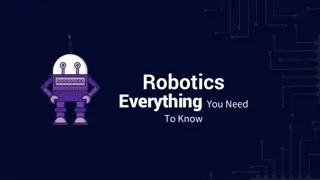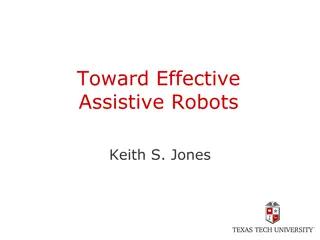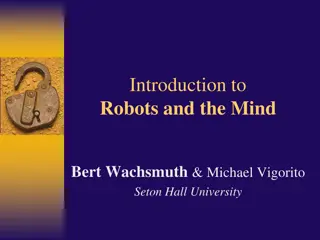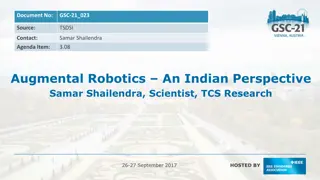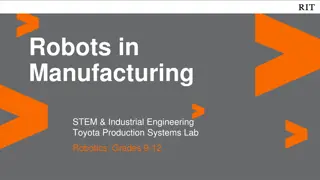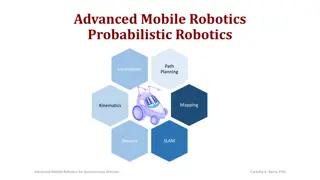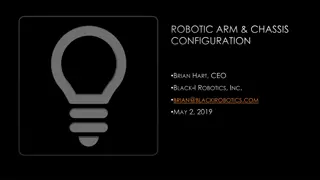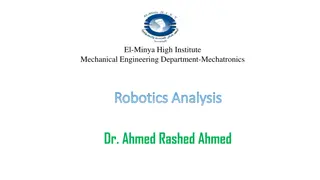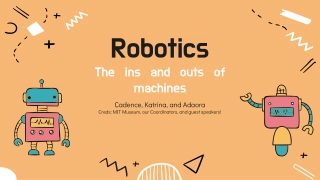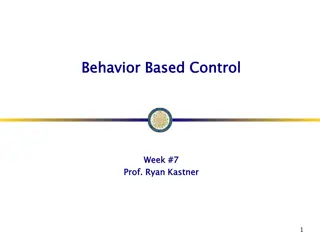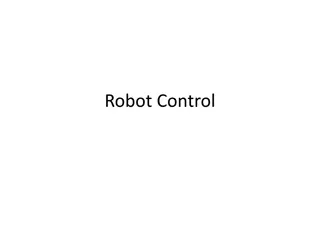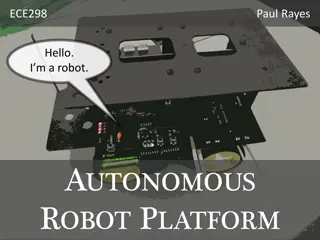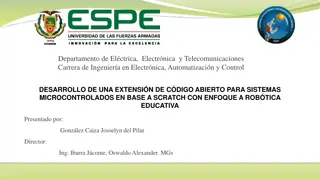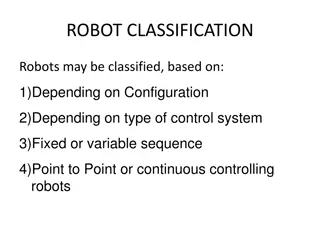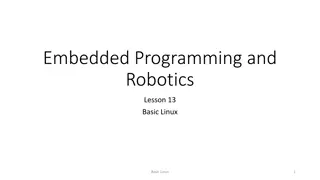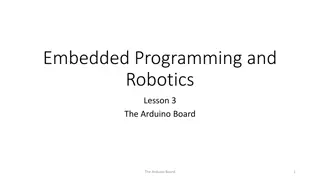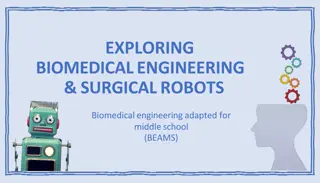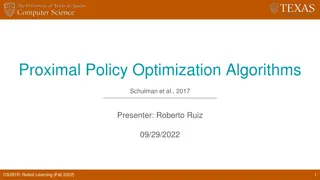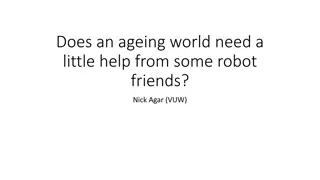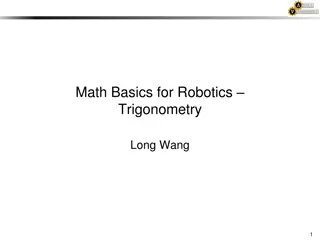Understanding Robotics: From Androids to Types of Robots
Robotics, a field with origins in Czech playwright Karel Capek's play, encompasses a diverse range of autonomous systems, including robots, androids, and cyborgs. Laws of Robotics proposed by Asimov highlight ethical considerations in robotics. Types of robots include manipulators and mobile manipulators, each designed for specific tasks.
Download Presentation

Please find below an Image/Link to download the presentation.
The content on the website is provided AS IS for your information and personal use only. It may not be sold, licensed, or shared on other websites without obtaining consent from the author. Download presentation by click this link. If you encounter any issues during the download, it is possible that the publisher has removed the file from their server.
E N D
Presentation Transcript
Robotics Dr. Waheed ur Rehman 1
Robot Defined Word robot was coined by a Czech novelist Karel Capek in a 1920 play titled Rossum s Universal Robots (RUR) Robota in Czech is a word for worker or servant Karel Capek Definition of robot: A robot is a reprogrammable, multifunctional manipulator designed to move material, parts, tools or specialized devices through variable programmed motions for the performance of a variety of tasks: Robot Institute of America, 1979 2
Robot A robot is an autonomous system which exists in the physical world, can sense its environment, and can act on it to achieve some goals. A robot is a re-programmable, multi-functional, manipulator designed to move material, parts, or specialized devices though variable programmed motions for the performance of a task (Robotics Industry Association) An autonomous robot acts on the basis of its own decisions, and is not controlled by a human. Robotics is the study of robots, which means it is the study of their autonomous and purposeful sensing and acting in the physical world. 3
Android and Cyborgs Androids are synthetic human beings with mechanical limbs and electronic brain. Cyborg is a human being which has been supplemented by some type of electromechanical devices. A cyborg uses robot-like parts to correct a physical deficiency or to enhance mental or physical capabilities 4
http://lookinside-images.amazon.com/Qffs+v35leoW+RGkuo00/4pTltbjFQankwoa6XfvAbz7xFtj9UzOGt8KC3QHBfGTQqXWGS6O+y0=http://lookinside-images.amazon.com/Qffs+v35leoW+RGkuo00/4pTltbjFQankwoa6XfvAbz7xFtj9UzOGt8KC3QHBfGTQqXWGS6O+y0= Laws of Robotics Asimov proposed three Laws of Robotics* Law 1: A robot may not injure a human being or through inaction, allow a human being to come to harm Law 2: A robot must obey orders given to it by human beings, except where such orders would conflict with a higher order law Law 3: A robot must protect its own existence as long as such protection does not conflict with a higher order law *If we ever able to make an android 5
Types of Robots Robot Manipulators Mobile Manipulators mm 6
Types of Robots Locomotion Aerial Robots Wheeled mobile robots Legged robots Underwater robots Humanoid 7
Mobile Robot Examples Hilare II Sojourner Rover http://www.laas.fr/~matthieu/robots/ NASA and JPL, Mars exploration 8
Quadcopter 10
Autonomous helicopter Goal: To develop a vision-guided robot helicopter which can autonomously carry out functions applicable to search and rescue, surveillance, law enforcement, inspection, mapping, and aerial cinematography, in any weather conditions and using only on-board intelligence and computing power http://www-2.cs.cmu.edu/afs/cs/project/chopper/www/haughton-do.html 11
Example 12
Why Use Robots? Application in 4D environments Dangerous Dirty Dull Difficult 4A tasks Automation Augmentation Assistance Autonomous 13
Why Use Robots? Increase product quality Superior Accuracies (thousands of an inch, micro inch) Repeatable precision Consistency of products Increase efficiency Work continuously without fatigue Need no vacation Increase safety Operate in dangerous environment Need no environmental comfort air conditioning, noise protection, etc Reduce Cost Reduce scrap rate(1) Lower in-process inventory (2) Lower labor cost Reduce manufacturing lead time Rapid response to changes in design Increase productivity Value of output per person per hour increases (1) Percentage of failed assemblies or material that cannot be repaired or restored, and is therefore condemned and discarded. (2) company's partially finished goods waiting for completion and eventual sale A lead time is the latency between the initiation and execution of a process. For example, the lead time between the placement of an order and delivery of a new car from a manufacturer may be anywhere from2 weeks to 6 months. 14
Programmable Universal Machine for Assembly 1968 Unimation (first robot company) takes its first multi-robot order from General Motors. PUMA 560 Manipulator 15
Shakey Shakey the robot Shakey (Stanford Research Institute) the first mobile robot to be operated using AI techniques Simple tasks to solve: To recognize an object using vision Find its way to the object Perform some action on the object (for example, to push it over) http://www.frc.ri.cmu.edu/~hpm/book98/fig.ch2/p027.html 16
Components of a robot Manipulator arm 17
Sensing Sensors are physical devices that enable a robot to perceive its physical environment in order to get information about itself and its surroundings. 18
Sensors 19
Sonar 20
Actuators The actuator is also referred to as the power source Three different types Electric Hydraulic Pneumatic 21
Actuators Pneumatic Cylinder Hydraulic Motor Stepper Motor DC Motor Pneumatic Motor Servo Motor 22
Degrees of Freedom A degree of freedom (DOF) is any of the minimum number of coordinates required to completely specify the motion of a mechanical system. 24


